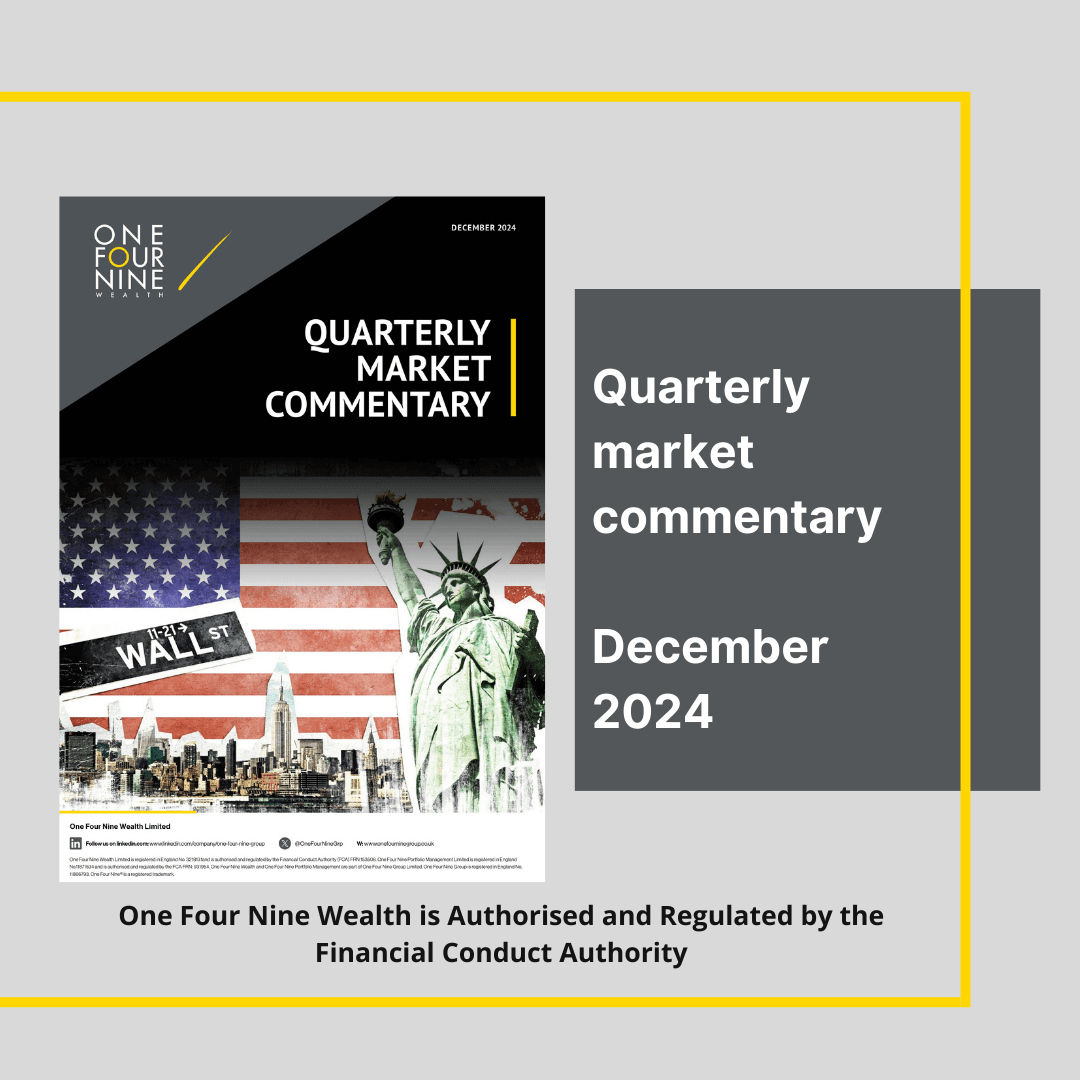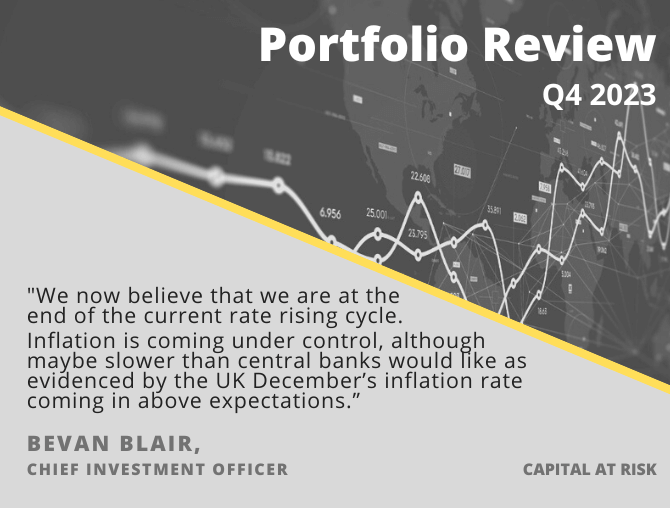Portfolio Review – Q4 2022 – Issue 17
This is the latest One Four Nine Portfolio Management (OFNPM) portfolio review providing investors and advisers with an easy to digest overview of what’s happening in the markets globally, alongside comparisons of OFNPM’s portfolio performance each quarter and throughout the year.
Chief Investment Officer’s comments
We may never see a year like 2022 again, or at least not in the foreseeable future, as there are no certainties in markets. Inflation reared its ugly head after we thought we had permanently controlled the monster and at a time when we had the loosest monetary policy in history. The confluence of these two conditions, high inflation and loose monetary policy, caused an earthquake in bond markets, the likes of which has never been seen before, and there has been real pain for investors to endure as a consequence.
As central banks realised that the moderate inflation during 2021 would not fall back towards their target rates quickly, mainly due to elevated and increasing energy prices, continuing disruption to global supply chains and loose fiscal policy, they acted with the only tool at their disposal; tighter monetary policy via raising base rates and quantitative tightening.
The rate rises we have seen from central banks have been the largest and fastest in history, and all starting from rates at historical lows. They have been universal across developed economies, apart from Japan. The table below shows the “base rate” for the major developed economies and how it has evolved over the year.
| Central Bank Base Rates | Dec-21 | Dec-22 | Number of Rate Rises |
| US | 0.25% | 4.50% | 7 |
| UK | 0.25% | 3.50% | 8 |
| Eurozone | 0.0% | 2.50% | 4 |
| Japan | -0.1% | -0.1% | 0 |
Source: Bloomberg
Inflation has been the driver of these rate rises during the year, and it has remained stubbornly high, although there are signs that it has peaked.
| Inflation | Dec-21 | Dec-22 | Maximum |
| US | 7.0% | 6.5% | 9.1% |
| UK | 5.4% | 10.50% | 11.1% |
| Eurozone | 5.0% | 9.2% | 10.6% |
| Japan | 0.8% | 4.0% | 4.0% |
Source: Bloomberg
In the US, the rate at the end of the year was lower than at the beginning with the rate substantially below its peak. In the UK and Europe, with their dependency on natural gas for energy needs, inflation has peaked higher and later than in the US, but even here inflation has started to fall slowly. This may be a sign that central bank actions are having the desired effect on inflation, and if they can keep inflation down then we may be heading towards the end of the rate cycle.
Certainly, markets think so as they are now pricing in no more than 2 or 3 more rate rises, and for the current cycle to end by the second quarter of 2023. Central banks are wary of inflation though, and while they are cognisant of the fact that it has been mainly supply side driven, they are cautious about the longer-term effects of higher demand on the back of higher wage growth.
China – open for business
They also need to be wary of the effect of a re-opening Chinese economy. China has been a closed shop for nearly 3 years and the relaxation of covid restrictions may well release a large amount of pent-up demand. This would be inflationary globally, and the deflation that China had been exporting for decades could easily turn into an export of inflation, especially if this demand supports raw material prices.
The signs are however hopeful. Hopeful that rates have peaked and hopeful that inflation too has peaked and will now fall back towards target for most central banks. Yields on bonds are now at a level that supports their underlying riskiness, at least in certain parts of the credit curve, and investors should now experience more bond like returns from bonds over the year.
The equity markets biggest worry, apart from a general increase in the cost of capital, has been the effect that these rate rises would have on economic growth. In the US the first and second quarter saw falls in GDP, with the US entering a technical recession. However, the third and fourth quarters saw a return to growth at just under 3% annualised. Moreover, the effect so far on corporate earnings has not been the disaster that many feared. Earnings have held up surprisingly well and many corporates have been able to pass on some price increase to consumers without a significant fall in demand. It seems now that the likely scenario is for below average growth for a while, but no outright global recession, especially if China starts to expand again. In the UK and Europe there has been lower growth in the second half of the year, but not as worse as was first feared and that if there is a recession it will be shallow and shorter than expectations.
The big unknown though is what the longer effect of rate rises in the second half of the year will have on growth. In general, it takes around 9 months for the effects of a rate rise to be felt in the real economy, so we are only now feeling the effect of rates rising from historic emergency levels to very low. The rate rises in the second half of the year will start to manifest themselves in the second quarter of 2023, so we are not out of the woods yet in terms of a recession, economic growth, and its effect on corporate earnings.
Future returns?
So, what are the expectations for returns in the future? We start in a much better place for expected long-term returns now than we did a year ago. It is highly unlikely that we see a repeat of last year in bond markets this year. Starting yields are significantly higher now, and more importantly the riskiness, as measured by duration is lower. The payoff of bonds is far less asymmetric than it was 12 months ago, and their risk is lower. We are starting to get paid for taking risk again in bond markets. This is especially true in investment grade markets at the lower credit quality end. It will take a number of years to repair the damage, but if yields start to drift downwards, even slowly, then capital will recover.
Equity markets had an unremarkable year, and while there was significant sector rotation, the overall return was well within spread expectations. In almost every calendar year since 1969 we have had a period where equities have drawn down by more than 10%, so the drawdowns of last year were not unusual. Valuations are looking much more reasonable, especially in the US, and earnings are holding up well, despite rate rises and recession fears. Again, the balance of probabilities is for a better year than last, although given that equity markets in the short-term are driven by sentiment, either fear or greed, there is no certainty. But long-term the starting point, like with bonds, is much better.
With cash starting to offer some decent nominal returns, bonds through the worst of the rate rises, and equities at a better valuation point, there is a significantly higher probability that a balanced portfolio performs better than last year, providing positive return and providing some diversification, a feature they sorely lacked last year. For those that were uninvested last year, this is now a good point to enter the market, and for those that have ridden the wave, there is much to be hopeful about recovery in hard earned capital.
Market Performance
Sterling bond markets made a small recovery over the quarter as yields eased back after the appointment of a new government in the UK was welcomed by market participants. The elevated levels of volatility in the market fell, and the ten-year gilt yield fell from 4.1% to 3.7%. Falling yields was not experienced over the whole yield curve however with longer yields rising, while those in the 1-5 year and 5-10 year range saw the biggest falls. Gilts overall returned 1.7% over the quarter, but short dated gilts (1-5 years) gained 3.2%, and medium dated (5-10 years) gilts gained 4.8%. Long Gilts (10 years plus) fell 0.7%.
Index linked gilts suffered large falls with the index down 6.0%. This is a consequence of the long dated nature of index linked gilts with yields rising, and the market selling them off as inflation expectations fell.
Sterling investment grade credit outperformed gilts as spreads continued to tighten. Sterling corporate bonds gained 7.3% over the quarter, while sterling high yield bonds gained 6.5%. Short dated sterling bonds, where the majority of our portfolios are invested, gained 5.0%.
Equity markets generated positive returns last quarter as yields eased slightly, and the threat of a long deep recession began to be discounted. The US market gained 7.6% over the quarter, but this gain was wiped out for sterling investors as the pound gained over 8% against the dollar during the quarter.
In the UK large cap stocks gained 8.7%, but mid cap stocks outperformed gaining over 10% as investors sought to pick up some bargains after large falls earlier in the year. Small cap stocks rallied somewhat gaining just over 7%, and the market overall gained 8.9%.
The best performing equity market was Europe, gaining 12.4% during the quarter, with its more value orientated stocks leading the way. Japan was more muted with stocks gaining just over 3%. Emerging market stocks gained 6.6% in local currency terms and 9.8% in dollar terms as dollar weakness was experienced globally.
Global equities in sterling terms gained 1.8% over the quarter and value stocks (+6.5%) outperformed growth stocks (-2.8%) over the quarter. The best performing sector was Energy with stocks rising 10.9%, followed by Industrials (+9.4%) and Basic Materials (+8.8%). The only two sectors to retrench over the quarter were Information Technology (-2.5%) and Consumer Discretionary (-9.4%), a sign that markets still have on eye on recession.
Oil continued to weaken with the price falling just over 2%, but gold had a good quarter rising 9.8%, clearly a sign that some market participants are hedging their bets on recession and inflation. As we have noted the dollar weakened substantially over the quarter with the trade weighted dollar index falling 7.7%.
Portfolio performance
Your portfolios generated positive returns over the quarter, with higher risk portfolios outperforming lower risk portfolios. The table below shows returns for Active, Passive and Sustainable portfolios, alongside the returns of their respective inflation benchmarks and for comparison purposes their appropriate IA sector over the quarter.
| 3 Months to 30 December 2022 | Active | Passive | Sustainable | Inflation Benchmark | IA Sector |
| Defensive | 2.25% | 2.36% | 2.73% | 2.92% | |
| Cautious | 2.30% | 2.74% | 2.37% | 3.16% | 2.31% |
| Balanced | 2.36% | 3.22% | 2.09% | 3.39% | 3.10% |
| Growth | 2.31% | 3.55% | 1.75% | 3.61% | 3.00% |
| Adventurous | 2.18% | 3.84% | 1.50 | 3.84 |
Source: One Four Nine Portfolio Management and Morningstar
Our Active portfolios slightly underperformed the Passive portfolios over the quarter. This was driven by a number of our equity funds underperforming their benchmarks, suffering slightly from their growth bias as growth underperformed value. Our European holdings of our global equity managers underperformed the European index and accounted for most of the underperformance of our Active models against our Passive models. Our active bond funds outperformed their passive counterparts in a rising market.
While not a benchmark our Passive portfolios outperformed, and our Active portfolios underperformed their respective IA sectors. Given our high weight to US equities, relative to other UK fund managers, the quantum of underperformance is lower than expected and was driven by good stock selection by our global managers in particular.
The chart below shows the returns of funds within the portfolios for the quarter.

Source: Morningstar
All of our bond funds, both active and passive, posted positive returns over the quarter. M&G UK Inflation Linked Corporate Bond fund was the best performer up 4.7% over the quarter, while the passive Vanguard UK Short-Term Investment Grade Bond Index was up 4.1%. Overall our bond funds gained 2.8% over the quarter.
Our equity funds, with their growth bias, underperformed their passive counterparts over the quarter, but still made positive returns. Our active equity funds gained 2.3%, but their passive equivalents gained 4.3%. Our three UK equity funds were the best performers all gaining over 6%, but this against the UK market up nearly 9%. Overweights to consumer staple stocks and zero weights to energy and mining stocks were in the main the reason for the underperformance.
Our global funds fared better with three of the five outperforming the MSCI World index, although the outperformance was small both ways. Our two Asian funds provided negative performance, both down around 4%, while Asian markets in sterling terms were up just over 2.9%.
We remain committed to our equity growth bias within portfolios, not least because the majority of our funds have continued to report that their underlying holdings have on average grown their earnings over the year. We invest for the long-term growth in earnings rather than try to trade the valuation cycle.
Portfolio outlook
We made no changes to the portfolios over the quarter. Overall, our long-term outlook remains unchanged, but there are now some medium-term opportunities in bonds and equities. Expected returns for all asset classes look much better than they did a year ago and there is some room to add risk in portfolios, mindful that if the recessionary conditions worsen that there will be short-term pain. The balance of probabilities is for better long-term performance from portfolios.
Find out how One Four Nine Portfolio Management invest here.
Dr Bevan Blair,
Chief Investment Officer,
One Four Nine Portfolio Management
London, Wednesday 08 February 2023.
All investment views are presented for information only and are not a personal recommendation to buy or sell. Past performance is not a reliable indicator of future returns, investing involves risk and the value of investments, and the income from them, may fall as well as rise and are not guaranteed. Investors may not get back the original amount invested.
All data is at 31 December 2023. One Four Nine Models are benchmarked against UK CPI and any other benchmark has been displayed for comparative purposes only and is not a benchmark for the Models. Performance figures are net of underlying fund fees and include One Four Nine Portfolio Management’s Management Fee of 0.24% (including VAT). All model portfolio performance data is sourced from One Four Nine Portfolio Management. All other data is from Bloomberg and Morningstar.
This service is intended for use by investment professionals only. This document does not constitute personal advice. If you are in doubt as to the suitability of an investment, please contact your adviser.
One Four Nine Group Limited Registered in England No: 11866793. One Four Nine Portfolio Management Limited is registered in England No: 11871594 and is authorised and regulated by the Financial Conduct Authority (FCA) FRN: 931954. One Four Nine® is a registered trademark.











